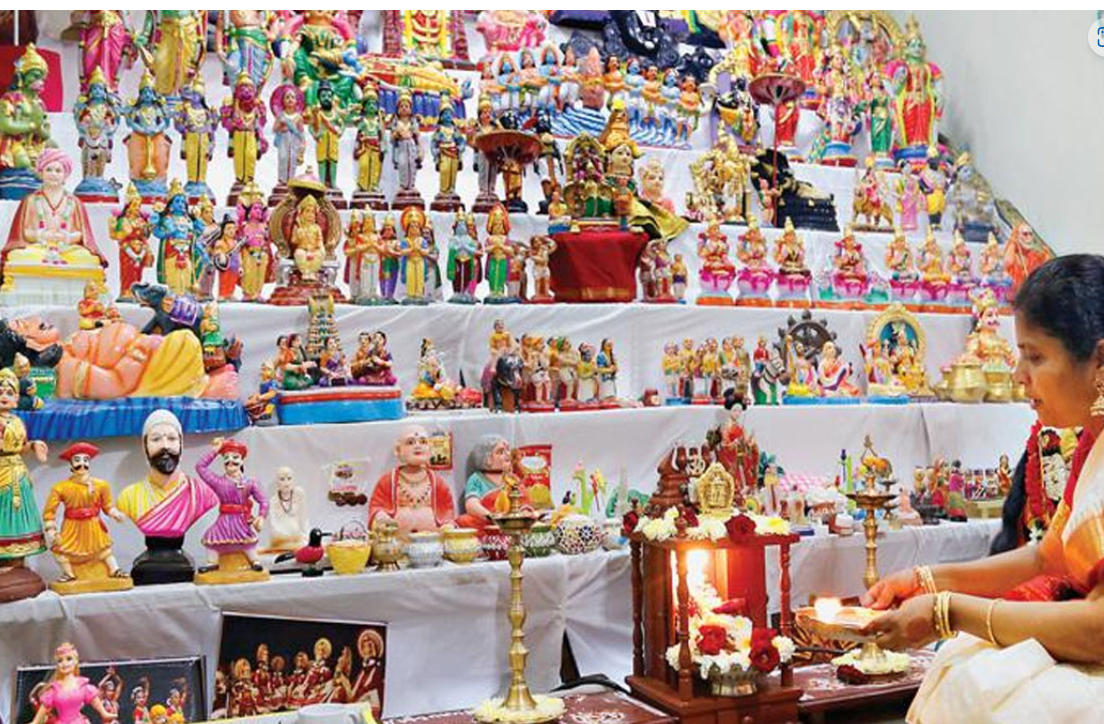Table of Contents
Navratri Golu
Why in news?
Bommai Golu or the Navratri Golu — decorated display of dolls and figurines — is an integral part of the festivities in South Indian households.
Key Points
- In Tamil Nadu, Karnataka, and Andhra Pradesh, the festival includes placing dolls of a multitude of gods, goddesses, animals, men, and children on a step-like set-up.
- In Tamil, Bommai Golu or Kolu means ‘Divine Presence’, in Telugu, Bommala Koluvu means ‘Court of Toys’, and in Kannada, Bombe Habba means ‘Doll Festival’.
- Golu consists of a makeshift staircase on which the dolls, which have been passed on from many generations are kept. Characters from Ramayana, Puranas, and Dashavataram are depicted.
- Golu also depicts particular themes like environment, space, mythology, current affairs, and more.
Record Sugar Production in India
Why in news?
- India has emerged as the world’s largest producer and second-largest exporter of sugar.
Sugar Season 2021-22
- In Sugar Season 2021-22, a record of more than five thousand lakh metric tons of sugarcane was produced in the country. Out of this, 35 lakh metric ton of sugar was diverted to ethanol production and 359 lakh metric ton of sugar was produced by sugar mills.
- The season has proven to be a watershed season for the Indian Sugar Sector. Records highest sugar exports of over 109 lakh metric tons have been registered.
How did India achieve this feat?
- The success story of the sugar industry is the outcome of synchronous and collaborative efforts of Central and State Governments, farmers, and sugar mills with a supportive overall ecosystem for business in the country.
- Supportive international prices and Central government Policy led to this feat of the Indian Sugar Industry.
- These exports earned foreign currency of about 40 thousand crore rupees.
India registers a decline in female IMR
Why in news?
- India has registered decline in female infant mortality rate. The country’s female Infant Mortality Rate (IMR) dropped to same level as males.
- However in sixteen states, IMR remained higher for female babies than male but the gap had reduced since 2011.
Key Points
- Infant mortality rate is the number of infant deaths for every one thousand live births.
- According to Sample Registration System Statistical Report 2020, Chhattisgarh had the highest gap in 2020, with a male infant mortality rate of 35 compared to female infant mortality rate of 41.
How did India achieve this?
- Efforts made towards Beti Bachao Beti Padhao through an integrated approach encompassing advocacy, healthcare and education is breaking the gender bias and resulting in improved numbers across all parameters.
OPEC+ to Cut Oil Production
Why in news?
Organization of the Petroleum Exporting Countries (OPEC) and its Russia-led allies have agreed to cut oil production by two million barrels a day at a Vienna meeting. It is the deepest cuts to oil production since the 2020 COVID pandemic.
How oil production cut will it impact the world?
- The supply cut will hit countries already reeling from high prices while the global economy is dealing with the continued negative impact of Russia’s attack on Ukraine.
- The cut could spur a recovery in oil prices that have dropped to about 90 dollars from 120 dollars three months ago on fears of a global economic recession, rising US interest rates, and a stronger dollar.
- However, the cut in real terms might be less than the headline figure, with multiple OPEC members currently producing less than their assigned quota.
What is Opec+?
- Opec+ is a group of 23 oil-exporting countries which meets regularly to decide how much crude oil to sell on the world market.
- At the core of this group are the 13 members of Opec (the Organisation of Oil Exporting Countries), which are mainly Middle Eastern and African countries. Opec was formed in 1960 as a cartel, with the aim of fixing the worldwide supply of oil and its price.
- Today, Opec nations produce around 30% of the world’s crude oil. Saudi Arabia is the biggest single oil producer within Opec, producing more than 10 million barrels a day.
- In 2016, when oil prices were particularly low, Opec joined forces with 10 other oil producers to create Opec+.
- Those new members included Russia, which also produces over 10 million barrels a day.
- Together, these nations produce about 40% of all the world’s crude oil.




 TSPSC Group 1 Question Paper 2024, Downl...
TSPSC Group 1 Question Paper 2024, Downl...
 TSPSC Group 1 Answer key 2024 Out, Downl...
TSPSC Group 1 Answer key 2024 Out, Downl...
 UPSC Prelims 2024 Question Paper, Downlo...
UPSC Prelims 2024 Question Paper, Downlo...




